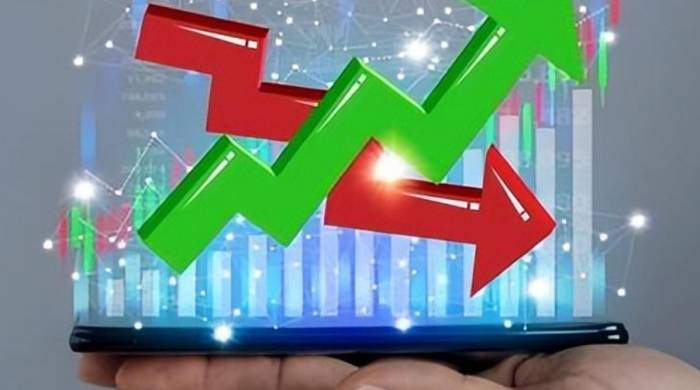Perfect integration of total A-share market value and GDP
Is there a simplest method to roughly measure the bottom and top of the Chinese stock market? Actually, such a method does exist.The total market value of our A-shares was at its lowest this year at 6...
Is there a simplest method to roughly measure the bottom and top of the Chinese stock market? Actually, such a method does exist.
The total market value of our A-shares was at its lowest this year at 67 trillion yuan, while China's GDP in 2023 was 126.06 trillion yuan. The ratio of the total market value of China's stock market to GDP generally operates between 50-80%. If the total market value of A-shares is below 50%, it indicates that the stock market is at the bottom. If it is above 100%, it is mostly at the top.
When the total market value of A-shares was at 67 trillion yuan, the proportion of the total market value of A-shares to China's GDP was 53%, making A-shares definitely undervalued.
The surge in A-shares, from 2689.70 points to 3336.50 points, increased by 646.80 points. This huge surge has made many people fearful and worried. They think whether the top of A-shares is coming soon, but there is no need to worry at all. Of course, above 3000 points in A-shares, there are a lot of profit-taking and trapped positions, and normal adjustments are inevitable.
On September 30, the total market value of A-shares closed at 84.5 trillion yuan, and China's GDP in 2023 was 126 trillion yuan. The current total market value accounts for 69% of A-shares' GDP. According to this calculation, the Shanghai Stock Index indicates that A-shares still have at least a 31% increase. According to the most conservative estimate, the index increase of A-shares is around 4370 points.
Please look at the following data: In 2007: A-shares had 1,497 stocks, with a total market value of 28.82 trillion yuan, accounting for about 107% of GDP.
In 2008: When A-shares were at 1664 points, the total market value was 11.49 trillion yuan, accounting for less than 36% of GDP.
In 2015: A-shares had 2,750 stocks, with a total market value of 71 trillion yuan, accounting for about 103% of GDP.
In 2021: A-shares had 4,690 stocks, with a total market value of 90 trillion yuan, accounting for about 79% of GDP.
In the 2007 bull market, the proportion of A-shares' total market value to GDP was 107%, and in the 2015 bull market, the proportion was 103%. This means that this bull market of A-shares should at least rise to around 4500 points.Currently, there are 5,380 stocks in the A-share market, and the market capitalization is also much larger than the total market value at that time. Naturally, the increase in the A-share market should be greater than that in 2007 and 2015. Moreover, this wave of the market is a "long-term bull market" advocated by the country, rather than short-term sharp rises and falls!
If this wave of the market can reach 4,500 points, then this is a perfect integration of the total market value of A-shares and GDP. Of course, the rise in the stock market will not happen overnight, and fluctuations and adjustments during the period are also inevitable. As long as the rhythm is stepped on, it should be the best and rare opportunity to change one's life in this wave of the market.
Buffett has been selling U.S. stocks recently, including Bank of America and Apple. So why is Buffett selling the optimistic Bank of America and Apple?

Buffett has his own set of research indicators, which are based on the ratio of the market value of the U.S. stock market to the Gross National Product (GNP). Buffett believes that if this ratio is within the range of 70% to 80%, buying stocks will yield good returns. If the ratio is too high, there may be a bubble.
According to the latest data, Buffett's indicator for the U.S. stock market has soared to 184%, which is the highest point in the past two years. This value indicates that the valuation of the U.S. stock market is too high and may suffer a devastating collapse. This is the warning effect of Buffett's indicator on the stock market and the reason why Buffett sells stocks and holds a large amount of cash.
The Buffett indicator for the Chinese stock market is currently at 61.48%, which indicates that the overall Chinese stock market is still undervalued, meaning it is too early to talk about the top of A-shares.
On September 30, the total market value of A-shares increased by 9.32%, but the balance of financing in Shanghai and Shenzhen only increased by 1.36%. The lowest balance was 1.36 trillion, and now it is 1.3837 trillion, which means it has increased by 6.5 billion points, and the financing only increased by 23.7 billion, indicating that there is still a lot of potential in the future.
Due to restrictions, many new investors who have just entered the market cannot participate in the trading of the ChiNext and STAR markets. New investors need to wait until the next day after opening an account to participate in trading, so there will be a lot of funds coming in the future.
The above is only my personal opinion and is not intended as investment advice. Please operate at your own risk, and I will not be responsible for any gains or losses.